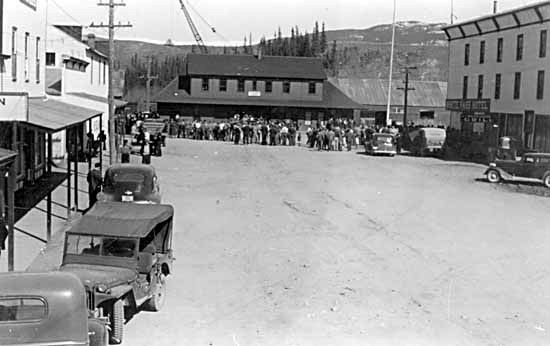White Pass & Yukon Route Railroad Depot
The White Pass & Yukon Route Railroad Depot is associated with two historic themes of relevance to the Alaska Highway Corridor nomination:
♦ Engineering achievement and North American strategic cooperation
♦ Half century of continuity and accelerated change
Description of the Site
The White Pass & Yukon Route Railroad Depot is located at 1109 Front Street (First Avenue) in the City of Whitehorse, Yukon. Since the founding of Whitehorse in 1900, the White Pass & Yukon Route Railroad has occupied an iconic status in the community. This was the entry point for most of Yukon’s freight and passengers, as well as the head of Yukon River sternwheeler navigation. The site has lost some of its original context, however, since the sternwheeler era ended in the mid-1950s and the end of rail operations in 1982.
History
Whitehorse was founded in the winter of 1899-1900, shortly after the Klondike Gold Rush. The main function of this company town was to be the terminus of the newly-built railway between Skagway, Alaska and the Yukon interior, and the head of Yukon River sternwheeler navigation. The owner, White Pass & Yukon Railroad, and its associated enterprises, laid out the town site, purchased most of the property in the river valley, and handled lot sales. For nearly half a century, the White Pass & Yukon Route was the town’s main employer, and the railway depot the focal point for this activity.
After a major downtown fire in 1905, the Depot was quickly rebuilt and underwent a number of additions over the next half century, usually coinciding with times of increased economic activity. The last major change to the structure occurred in 1953, with foundation stabilization, an addition to the south, re-organization of the interior layout, and a new “log cabin style” exterior finish.
The greatest upheaval to the railway and Whitehorse came in 1942 when thousands of US Army soldiers and thousands more civilian workers – most arriving by rail – flooded into the town to work on a major wartime defence project, the Alaska Highway. Due in large part to its existing air, river and rail transport infrastructure, the town became the headquarters of the Northwest Service Command overseeing highway construction and two other wartime mega projects: the Northwest Staging Route, a series of airports and airfields extending from Edmonton, Alberta to Alaska along the highway route; and the Canol Project, including construction of a road and crude oil pipeline from Norman Wells, NWT to a new refinery in Whitehorse.
 Crowds assembled outside of the Depot at the intersection of Front and Main Streets (c 1942)
Crowds assembled outside of the Depot at the intersection of Front and Main Streets (c 1942)
Credit: Yukon Archives, R. A. Cartter Fonds, YA# 1553.
Within a few weeks, rail service went from once a week, to once a day, to once every few hours. Overwhelmed, the rail owners leased its operations to the US Army. For the duration of the war, the 770th Railway Battalion worked with train crews to keep trains running and the line open. The wartime period left Whitehorse with a greatly expanded population, insufficient municipal infrastructure, extensive riverfront squatter communities, a modern airport, and new communities above the valley, heralding the town’s movement away from the river and toward the new highway.
After a major economic recession in 1982 that resulted in the closing of all Yukon’s major mines, the railway shut down. It is now a seasonal tourist operation based in Skagway, Alaska. Although the train has never returned to Whitehorse, and White Pass has sold its riverfront properties, the company still retains its ownership of the railway right-of-way.
More recently the riverfront in Whitehorse has been revitalized with a seasonal trolley operation, a large pedestrian wharf behind the Depot, the striking new “Healing Totem Pole”, and landscaped trails and park areas. Although it no longer functions as a railway station, the Depot building continues to be a prominent landmark in downtown Whitehorse. This is a central location for many community celebrations and residents look forward to the seasonal presence of an oversize Christmas tree in front of the building.
Existing Heritage Recognition
The White Pass & Yukon Route Railroad Depot was municipally designated a historic site on 11 March 2002.

